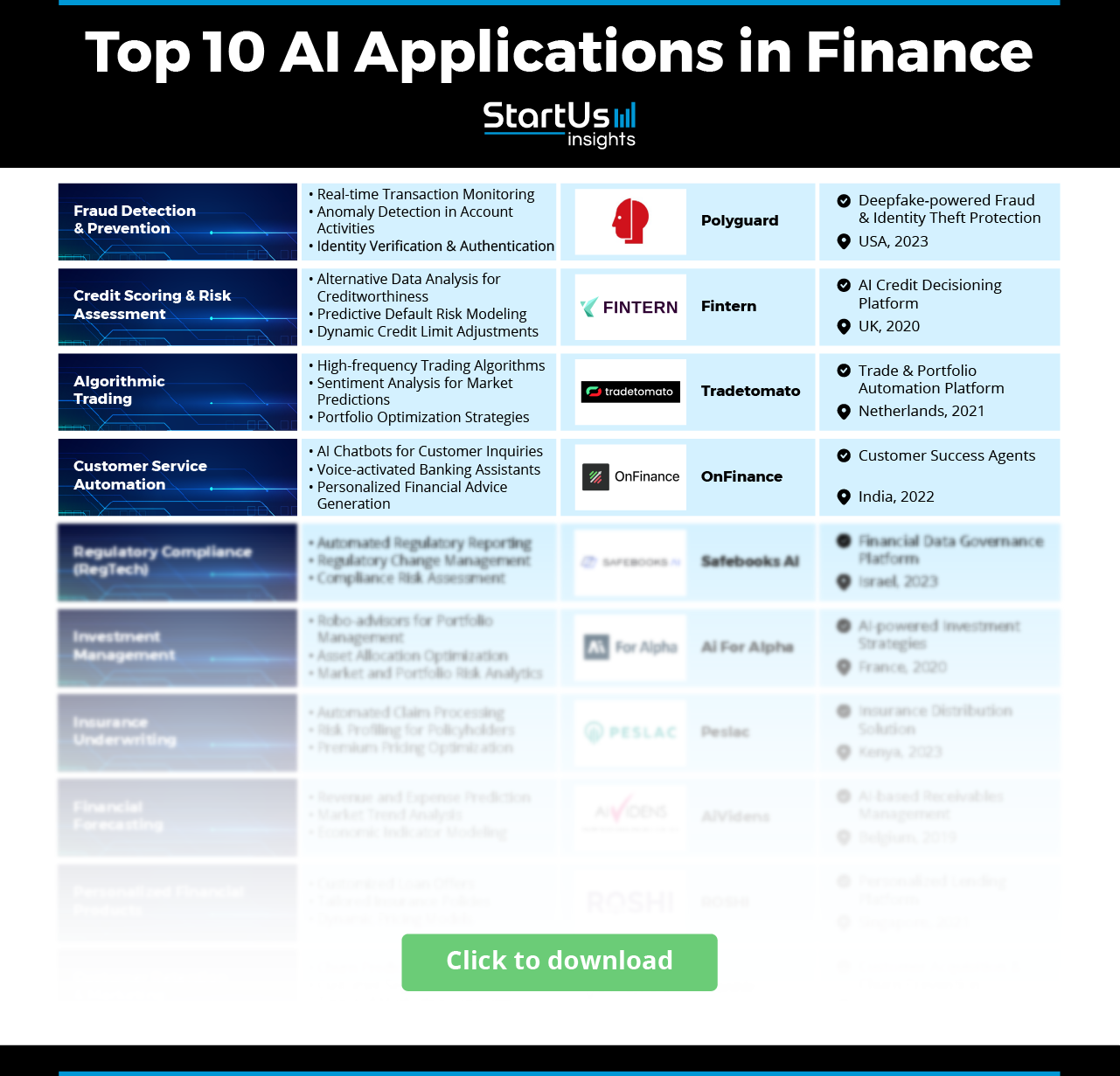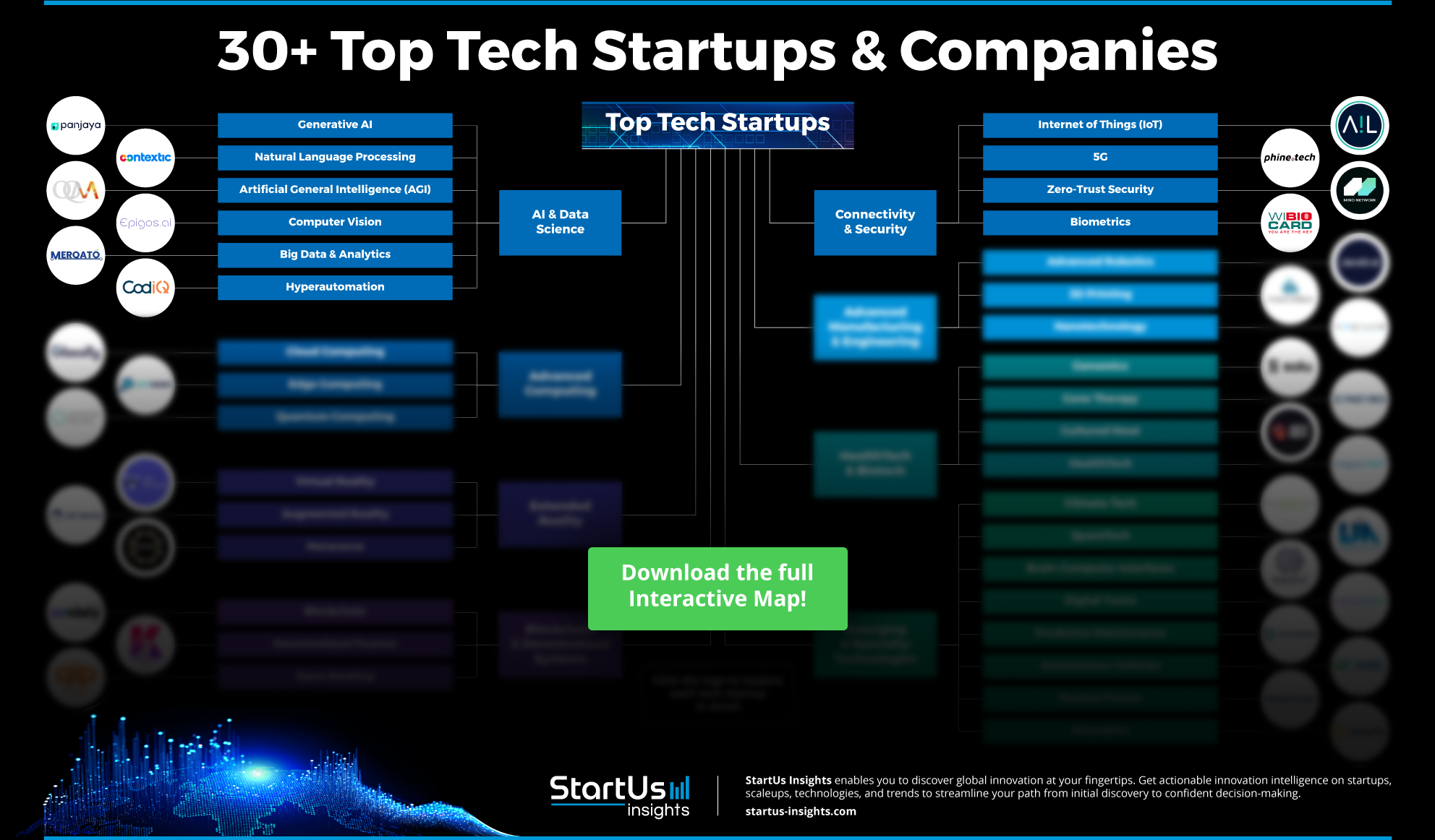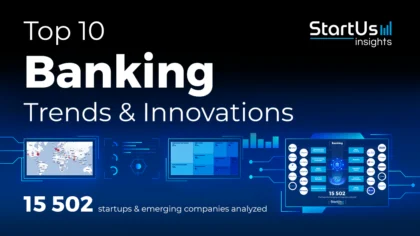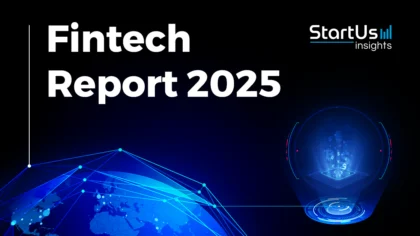AI is changing the finance industry by tackling critical challenges. Fraud detection systems use AI algorithms to identify unusual patterns and reduce fraudulent activities. For instance, novel AI-driven platforms like Fintern’s Render improve credit scoring and risk assessment with open banking data. AI also enhances algorithmic trading that enables faster and more accurate investment decisions. It automates customer service which increases efficiency and personalization.
In regulatory compliance, AI allows institutions to meet evolving legal requirements to reduce human error and operational risks. Startups like AiVidens use AI-powered receivables solutions to optimize cash flow management for improving financial forecasting and business stability. AI’s role extends to insurance underwriting, personalized financial products, and targeted marketing strategies. As AI and finance become increasingly interconnected, industry leaders must adapt to these innovations to maintain a competitive edge and ensure long-term success.
Why should you read this report?
- Gain in-depth insights into the top 10 AI applications in the finance sector
- Learn about three practical use cases for each application, showcasing various AI in finance examples
- Meet 10 innovative startups advancing these financial services

Key Takeaways
- Fraud Detection and Prevention
- Use Cases:
- Real-time Transaction Monitoring
- Anomaly Detection in Account Activities
- Identity Verification and Authentication
- Startup to Watch: Polyguard
- Use Cases:
- Credit Scoring and Risk Assessment
- Use Cases:
- Alternative Data Analysis for Creditworthiness
- Predictive Default Risk Modeling
- Dynamic Credit Limit Adjustments
- Startup to Watch: Fintern
- Use Cases:
- Algorithmic Trading
- Use Cases:
- High-frequency Trading Algorithms
- Sentiment Analysis for Market Predictions
- Portfolio Optimization Strategies
- Startup to Watch: Tradetomato
- Use Cases:
- Customer Service Automation
- Use Cases:
- AI Chatbots for Customer Inquiries
- Voice-activated Banking Assistants
- Personalized Financial Advice Generation
- Startup to Watch: OnFinance
- Use Cases:
- Regulatory Compliance (RegTech)
- Use Cases:
- Automated Regulatory Reporting
- Regulatory Change Management
- Compliance Risk Assessment
- Startup to Watch: Safebooks AI
- Use Cases:
- Investment Management
- Use Cases:
- Robo-advisors for Portfolio Management
- Asset Allocation Optimization
- Market and Portfolio Risk Analytics
- Startup to Watch: Ai For Alpha
- Use Cases:
- Insurance Underwriting
- Use Cases:
- Automated Claim Processing
- Risk Profiling for Policyholders
- Premium Pricing Optimization
- Startup to Watch: Peslac
- Use Cases:
- Financial Forecasting
- Use Cases:
- Revenue and Expense Prediction
- Market Trend Analysis
- Economic Indicator Modeling
- Startup to Watch: AiVidens
- Use Cases:
- Personalized Financial Products
- Use Cases:
- Customized Loan Offers
- Tailored Insurance Policies
- Dynamic Pricing Models
- Startup to Watch: ROSHI
- Use Cases:
- Customer Retention and Marketing
- Use Cases:
- Churn Prediction Models
- Customer Segmentation Analysis
- Targeted Marketing Campaigns
- Startup to Watch: Menhir
- Use Cases:
Applications of AI in Finance FAQs
How is AI used in finance?
AI integrates across financial sectors to enhance customer service and risk management. In banking, AI chatbots handle routine customer inquiries to improve efficiency and reduce staff workload. Machine learning models detect fraud by analyzing transaction data to identify unusual patterns in real time. AI also supports credit scoring by evaluating customers’ financial behavior to provide more accurate assessments than traditional methods. Further, in investment management, AI algorithms analyze market data to predict trends and inform trading decisions.
How will AI and automation shape finance in the future?
AI and automation are driving operational efficiency, reducing costs, and enhancing decision-making in finance. AI tools are enabling real-time risk assessments and automated regulatory compliance checks to make financial operations more agile. Generative AI will streamline tasks like financial reporting, analysis, and fraud monitoring by analyzing large datasets quickly and accurately. As AI evolves, it will replace many repetitive tasks to allow finance professionals to focus on strategic decision-making and innovation.
Where is this Data from?
StartUs Insights provides data through its comprehensive Discovery Platform, which covers 4.7+ million startups, scaleups, and tech companies globally, as well as 20K+ emerging technologies & trends. The platform excels in startup and technology scouting, trend intelligence, and patent searches, offering a detailed view of the innovation landscape. For this report, we analyzed technologies within specific industries using the trend intelligence feature. During this research, we identified patterns and trends, pinpointing relevant use cases and the startups developing solutions for each. More capabilities and details are available at StartUs Insights Discovery Platform.
10 Top Applications of Artificial Intelligence in Finance [2025 & Beyond]
1. Fraud Detection and Prevention
AI plays a key role in detecting and preventing fraud in the finance industry. It uses machine learning algorithms and data analysis to identify and respond to fraudulent activities in real-time. AI systems analyze transaction data to detect patterns and anomalies that may indicate fraud, such as unusual spending behaviors or deviations from normal account activity. These systems use methods like anomaly detection, predictive analytics, and natural language processing to improve accuracy and efficiency, reducing false positives and enabling quick responses to threats. By learning from new data, AI adapts to evolving fraud tactics that aid financial institutions in safeguarding assets, complying with regulations, and maintaining customer trust.
3 Practical Use Cases of AI in Fraud Detection & Prevention
- Real-time Transaction Monitoring: AI enables immediate analysis of transactions using real-time data processing and in-memory computing technologies. This allows financial institutions to detect and block fraudulent transactions as they occur, using machine learning models for quick decision-making.
- Anomaly Detection in Account Activities: Unsupervised learning algorithms like clustering and autoencoders identify unusual patterns in account activities that deviate from typical user behavior. This anomaly detection uncovers subtle fraudulent actions that traditional rule-based systems might miss.
- Identity Verification & Authentication: Leveraging biometric technologies such as facial recognition and fingerprint scanning, AI improves identity verification processes. Machine learning models analyze biometric data to authenticate users to reduce the risk of identity fraud and unauthorized access.
Startup to Watch: Polyguard
US-based startup Polyguard develops the Polyguard Secure Line System to protect against deepfake fraud and identity theft. Its technology combines facial recognition, document proofing, and encryption to secure phone and video calls and verify identities in real time. It integrates 2D and 3D biometric processing that enables quick verification without traditional multifactor authentication like passwords or codes. The startup’s system works on iOS, Android, and desktop devices to ensure secure communications across various platforms. Polyguard benefits the finance industry, especially wealth managers and their clients, by protecting sensitive financial conversations from deepfake or AI-generated voice scams.
2. Credit Scoring and Risk Assessment
AI-based credit scoring systems use algorithms and machine learning to analyze various data sources, including social media activity and online transactions. This approach provides an evaluation of a borrower’s creditworthiness. These systems reduce biases, enable real-time monitoring to detect potential defaults early, and facilitate faster loan approvals through automation. In risk assessment, AI processes large datasets quickly and accurately to identify suspicious activities in real-time. Moreover, predictive risk models learn from new data to enhance their accuracy, reduce human bias, and promote equitable lending practices.
3 Practical Use Cases of AI in Credit Scoring & Risk Assessment
- Alternative Data Analysis for Creditworthiness: Machine learning algorithms analyze non-traditional data sources like utility payments, rental histories, and online transactions. This allows lenders to assess creditworthiness for individuals without extensive credit histories.
- Predictive Default Risk Modeling: AI models use predictive analytics to evaluate the likelihood of borrowers defaulting on loans. By analyzing historical data and identifying patterns, these models allow financial institutions to forecast risks and make informed lending decisions.
- Dynamic Credit Limit Adjustments: Monitoring customers’ financial activities through AI systems enables adjusting credit limits in real time. Machine learning algorithms assess spending patterns and financial health for personalized credit offerings that align with individual risk profiles and reduce the chance of defaults.
Startup to Watch: Fintern
UK-based startup Fintern develops Render, an AI-driven credit decisioning platform that changes how consumer loans are assessed using open banking and alternative data. The platform bypasses traditional credit scores to focus on real-time transaction data to provide a more accurate view of an applicant’s financial health. This approach expands access to affordable loans for consumers often underserved by conventional financial institutions. Render enables lenders to make better decisions for reducing default rates and offering fairer loan terms. Fintern improves financial well-being by enabling broader access to low-cost personal finance that allows individuals to avoid predatory lending practices and high-interest debt traps.
3. Algorithmic Trading
Leveraging machine learning and data analytics, AI-driven algorithmic trading automates trading decisions, optimizes portfolios, and manages risks. AI in algorithmic trading includes data analysis, pattern recognition, predictive modeling, risk management, and automated trading execution. These capabilities allow the development of trading strategies that anticipate market movements and optimize portfolios by identifying vulnerabilities and recommending protective strategies. Moreover, AI increases speed and efficiency which improves accuracy, enhances risk management, and enables emotion-free trading.
3 Practical Use Cases of AI in Algorithmic Trading
- High-frequency Trading Algorithms: Executes large volumes of trades quickly to capitalize on brief market opportunities. Machine learning models analyze real-time data to make split-second decisions, using reinforcement learning to optimize trading strategies with minimal latency.
- Sentiment Analysis for Market Predictions: Natural language processing interprets data from news articles, financial reports, and social media to gauge market sentiment. These insights enable machine learning algorithms to predict market trends that allow traders to make informed decisions based on market mood.
- Portfolio Optimization Strategies: Techniques like deep learning and evolutionary algorithms refine asset allocation in investment portfolios. By processing complex market variables and simulating scenarios, these AI systems identify strategies to maximize returns while minimizing risk.
Startup to Watch: Tradetomato
Dutch startup Tradetomato offers an AI-powered trade and portfolio automation platform that simplifies crypto trading with plug-and-play algorithms. The platform includes a crypto trading toolbox with customizable dashboards, backtesting, trading terminals, and staking options. The startup allows automating trading strategies across exchanges like Binance, Kraken, and Coinbase, using AI and machine learning for predictive trading. Tradetomato’s ecosystem uses the Tradetomato Token (TTM), a BEP20 token, to access platform features such as advanced modules, marketplace content, and staking rewards. Businesses benefit from Tradetomato’s automation tools and modular algorithms that improve efficiency and optimize trading strategies.
4. Customer Service Automation
Financial institutions use AI to automate customer support processes. AI-powered chatbots and virtual assistants handle routine inquiries across chat, email, and phone. This automation lets human agents focus on complex tasks to improve service delivery and customer satisfaction. AI also personalizes interactions by analyzing data to offer tailored financial advice and product recommendations based on client behavior. It also uses predictive analytics to anticipate customer needs and improve risk management by identifying behavior patterns.
3 Practical Use Cases of AI in Customer Service Automation
- AI Chatbots for Customer Inquiries: Use natural language processing and machine learning to handle complex customer queries accurately. They learn from interactions to provide detailed assistance and resolve issues autonomously.
- Voice-activated Banking Assistants: Leverages speech recognition and conversational AI to let customers perform banking tasks through voice commands. This technology enhances accessibility and user experience by enabling hands-free operations like balance inquiries and fund transfers.
- Personalized Financial Advice Generation: AI systems use predictive analytics and data mining to generate customized financial advice. By analyzing individual financial profiles and real-time market data, these tools offer tailored investment recommendations and strategic planning to optimize clients’ financial outcomes.
Startup to Watch: OnFinance
Indian startup OnFinance offers AI-powered customer success agents using NeoGPT, a language model for finance and banking to automate customer service. The platform personalizes responses based on the chat history and product updates to extract customer insights and improve engagement. The startup also automates agent onboarding and training to ensure smooth team integration. OnFinance enhances operational efficiency, accuracy, and compliance for businesses with features like customer satisfaction analysis, data governance, enterprise security, and grounded answers.
5. Regulatory Compliance (RegTech)
AI-driven solutions monitor transactions in real-time to ensure adherence to regulations like anti-money laundering (AML) and know your customer (KYC) by detecting suspicious activities and reducing false positives. It uses machine learning and natural language processing to analyze regulatory documents, extract relevant requirements, and translate them into actionable compliance tasks. This automation allows financial institutions to quickly adapt to regulatory changes and reduce manual effort in compliance management and reporting. Further, AI improves risk assessment by analyzing large datasets to identify potential compliance risks and emerging trends to enable proactive management.
3 Practical Use Cases of AI in Regulatory Compliance
- Automated Regulatory Reporting: AI systems automate the generation and submission of regulatory reports by extracting and organizing data from multiple internal sources. Machine learning algorithms ensure compliance by validating data accuracy and formatting it according to specific regulatory standards for reducing reporting time and errors.
- Regulatory Change Management: Predictive analytics and natural language processing monitor and interpret emerging regulatory updates. These technologies allow institutions to adjust their compliance strategies by mapping new regulations to internal policies to ensure timely adherence without manual intervention.
- Compliance Risk Assessment: Using advanced analytics, AI simulates potential risk scenarios. Also, deep learning models analyze diverse datasets to identify hidden compliance vulnerabilities to provide actionable insights for proactive risk mitigation and strengthening overall regulatory posture.
Startup to Watch: Safebooks AI
Israeli startup Safebooks AI develops a financial data governance platform to ensure data accuracy, integrity, and compliance. It uses AI and machine learning to automate financial controls across systems and monitors for errors, anomalies, and fraud risks in real time. The startup’s system integrates with Office of the CFO systems to unify financial data into a single, auditable source. It also includes automated reconciliation, fraud detection, and compliance checks to streamline processes and enhance decision-making. Safebooks AI allows businesses to audit financial data continuously to reduce manual effort and errors while maintaining security standards.

6. Investment Management
In finance, investment management is transforming with the adoption of AI, which enhances decision-making and manages risks. These technologies improve portfolio management by automating data collection and analysis that enables investment managers to focus on strategy development and client engagement. Managers get real-time monitoring and alerts to risk profile changes, with AI automating the detection of suspicious transactions. Moreover, the automation of repetitive tasks, such as report generation and query responses via machine learning-powered chatbots improves operational efficiency. By analyzing large datasets, AI identifies non-intuitive market relationships and evaluates management sentiment from earnings transcripts to aid in alpha generation.
3 Practical Use Cases of AI in Investment Management
- Robo-advisors for Portfolio Management: Use machine learning algorithms to automate investment portfolio creation and management. By assessing individual investor profiles and market data, they provide personalized investment recommendations and automatically adjust portfolios to align with client’s financial goals and risk tolerance.
- Asset Allocation Optimization: Using advanced AI techniques like predictive analytics and optimization algorithms, AI systems enhance asset allocation by identifying the optimal mix of assets. They analyze large datasets to balance risk and return and adjust allocations in response to market fluctuations and emerging trends.
- Market and Portfolio Risk Analytics: AI applies deep learning and statistical models to assess potential risks in markets and investment portfolios. The system processes historical and real-time data to detect patterns and anomalies that may indicate emerging risks, which enables investors to manage exposure and make informed decisions to mitigate potential losses.
Startup to Watch: Ai For Alpha
French startup Ai For Alpha offers AI-powered investment strategies for asset managers, institutional investors, and wealth managers. The platform uses deep reinforcement learning and machine learning to adapt portfolio allocations based on market conditions. The startup’s proprietary models analyze various market drivers, including macroeconomic data, interest rates, and market volatility, to provide transparent investment decisions. Its AI 360 portfolios deliver daily insights that allow clients to optimize risk-adjusted returns while reducing market risk. Ai For Alpha’s AI-driven method improves decision-making by identifying regime changes to ensure adaptable investment strategies for diverse asset classes.
7. Insurance Underwriting
AI streamlines underwriting by automating repetitive tasks to reduce data entry errors and allows underwriters to focus on high-value activities. It enables insurers to analyze large datasets quickly to improve risk assessment and decision-making. AI processes diverse data sources, such as historical claims and customer behavior, to provide precise risk evaluations and personalized insurance policies. This leads to faster quote generation, better quote-to-bind ratios, and increased customer satisfaction through a more transparent experience.
3 Practical Use Cases of AI in Insurance Underwriting
- Automated Claim Processing: AI automates claim handling by assessing and validating claims using machine learning algorithms. These systems quickly analyze claim information, detect potential fraud or inconsistencies, and expedite approvals, resulting in faster settlements and enhanced customer satisfaction without manual intervention.
- Risk Profiling for Policyholders: Advanced AI models create risk profiles by analyzing data from telematics, IoT devices, and behavioral analytics. This detailed risk assessment enables insurers to tailor insurance products more precisely to individual needs and risk levels.
- Premium Pricing Optimization: Machine learning algorithms consider factors like market trends, individual risk profiles, and competitive pricing to adjust premiums dynamically. This ensures insurers remain competitive while maintaining profitability and offering fair pricing to customers.
Startup to Watch: Peslac
Kenyan startup Peslac offers InsurSphere, an AI-powered insurance distribution solution, to streamline underwriting and policy management. InsurSphere has an API-first design that integrates with existing platforms and automates underwriting to reduce manual tasks and improve efficiency. It uses dynamic pricing models based on real-time data and customer insights for competitive pricing. Peslac’s scalable architecture supports businesses adapting to market changes. Insurers gain market reach, better customer experience, and optimized operations through automated processes.
8. Financial Forecasting
Machine learning, neural networks, and predictive analytics analyze large amounts of historical and real-time data to identify patterns and trends. This leads to more precise forecasts of financial metrics such as margins, revenue, and market trends to improve strategic planning and resource allocation. AI also enables real-time forecasting that allows businesses to update predictions as new data becomes available to enhance their ability to respond to market changes. Further, AI-driven insights aid in risk assessment and management by identifying potential financial risks and providing proactive solutions.
3 Practical Use Cases of AI in Financial Forecasting
- Revenue and Expense Prediction: AI uses time series analysis and machine learning algorithms to forecast future revenues and expenses. The system incorporates factors like customer behavior, market dynamics, and operational data to provide detailed financial projections that aid in strategic budgeting and financial planning.
- Market Trend Analysis: Leveraging data mining and natural language processing, AI examines large volumes of unstructured data, such as news articles, financial reports, and social media feeds. This analysis finds emerging market trends and sentiments that enable businesses and investors to make proactive decisions based on real-time market insights.
- Economic Indicator Modeling: Predictive analytics and neural networks model complex relationships between various economic indicators. By simulating different economic scenarios, these models allow policymakers and financial analysts to understand potential economic outcomes for supporting informed decisions on investments and economic strategies.
Startup to Watch: AiVidens
Belgian startup AiVidens provides an AI-powered receivables management solution to optimize cash flow and improve financial forecasting. It uses predictive algorithms to assess customer payment behaviors that allow companies to prioritize collection efforts and reduce liquidity risks. The startup’s system delivers cash flow forecasts to aid in better working capital management and streamlined accounts receivable processes. It integrates with existing ERP systems for quick implementation and easy automation. Further, it offers features like automated risk analysis, collection strategy simulation, and real-time data integration to enhance collection efficiency, reduce payment delays, and enable data-driven financial decisions. AiVidens provides credit managers with a tool to improve financial accuracy and operational efficiency.
9. Personalized Financial Products
Generative AI analyzes customer behaviors, preferences, and financial histories to recommend personalized financial products like credit cards, loans, and savings accounts. This personalization includes tailored investment strategies based on a customer’s risk tolerance and future goals to improve customer satisfaction and loyalty. AI-driven personalization also involves dynamic pricing models and individualized investment management approaches that enhance service quality and increase product acceptance. Moreover, AI tools enable financial institutions to deliver personalized content and financial advice through various digital channels, which improves customer engagement.
3 Practical Use Cases of AI in Personalized Financial Products
- Customized Loan Offers: Machine learning algorithms analyze individual financial data, credit history, and spending patterns that allow financial institutions to offer personalized loan products with terms and interest rates tailored to each customer’s needs and repayment capabilities.
- Tailored Insurance Policies: Using predictive analytics and data mining, AI assesses personal risk factors by examining data from sources like health records and lifestyle information. Insurers use this insight to design customized insurance policies with appropriate coverage levels and premiums unique to each policyholder.
- Dynamic Pricing Models: AI utilizes real-time data analytics and dynamic modeling to adjust financial product pricing. By analyzing market trends, customer behavior, and competitive factors, machine learning algorithms optimize pricing strategies to reflect current conditions to ensure profitability and customer value.
Startup to Watch: ROSHI
Singaporean startup ROSHI offers a lending platform that uses AI to match borrowers with tailored loan options in real time. It allows comparing loans from various banks and licensed moneylenders without applying through multiple sources. The startup’s algorithms analyze borrower profiles to provide personalized rates and terms based on individual financial circumstances. The borrowers monitor their applications and chat directly with loan specialists through a dashboard. ROSHI connects individuals with suitable lenders to offer options from personal loans to mortgage refinancing.
10. Customer Retention and Marketing
AI algorithms analyze customer data, including transaction history and behavioral patterns, to provide personalized recommendations and targeted marketing campaigns. It segments customers based on their preferences and behaviors which enables financial institutions to deliver relevant marketing messages for increasing conversion rates and customer satisfaction. Predictive analytics allows institutions to anticipate customer needs and identify potential churn risks that enable proactive measures to retain customers. In addition, AI-powered chatbots and virtual assistants offer 24/7 support to improve customer service efficiency and satisfaction by providing quick and personalized responses to inquiries. AI also facilitates cross-selling and upselling by identifying opportunities based on customer data to increase revenue potential.
3 Practical Use Cases of AI in Customer Retention & Marketing
- Churn Prediction Models: Machine learning algorithms like neural networks and decision trees predict customer churn by analyzing patterns in transactional data, engagement metrics, and customer interactions. These predictive models enable financial institutions to identify at-risk customers proactively and implement targeted retention strategies before churn occurs.
- Customer Segmentation Analysis: Using unsupervised learning techniques such as k-means clustering and principal component analysis, AI systems categorize customers into distinct segments based on attributes like spending habits, product usage, and demographics. This segmentation allows for tailored marketing efforts and personalized service offerings that resonate with each group.
- Targeted Marketing Campaigns: AI enhances marketing effectiveness by employing predictive analytics and real-time data processing to optimize campaign elements. Machine learning models analyze customer responses and engagement levels to adjust messaging, timing, and channel selection dynamically to ensure that marketing campaigns are precisely targeted for maximum conversion and return on investment.
Startup to Watch: Menhir
Spanish startup Menhir provides AI-driven solutions for financial services, focusing on customer acquisition, retention, and fraud prevention. It uses AI models and algorithms to analyze vast datasets—transaction records, customer interactions, and market trends—to predict customer behavior, assess credit risks, and detect fraud. Menhir’s Decision Apps offer tools for financial institutions to optimize loan collection and enhance customer engagement using real-time data and predictive insights. These applications allow businesses to tailor strategies for preventing customer churn and improving retention with personalized interventions. Menhir’s Data Fabric also integrates data from multiple sources to create a unified view that informs decision-making and predictive analytics.
Act Now to Take Advantage of Top AI Technologies in Finance
Investors like Y Combinator, Techstars, Antler, Google for Startups, and 500 Global support AI-focused startups in finance. They provide resources to drive innovation, with funding that spans seed, early-stage VC/Series A, pre-seed, angel, and venture-round investments. These investments foster technological development in this sector and encourage AI solutions that enhance financial services, risk management, and customer engagement.
Take immediate action on the emerging artificial intelligence and finance technologies to stay ahead in the industry. StartUs Insights empowers you to uncover hidden opportunities among 4.7 million startups and tech companies, alongside insights into 20K+ technologies and trends. Our AI-powered, real-time database provides unparalleled access to solutions that are not available elsewhere, ensuring you always lead in innovation.
Major companies like Samsung, Nestlé, and Magna rely on our tools to spearhead trends and optimize operations. For example, here’s what Dóra Avar, Innovation Consultant of OTP Group says about our platform, “StartUs Insights enables us to discover new partners for PoCs, scale our outreach, and further strengthens OTP’s position as a leading innovation player globally.”
Like them, you can also dive into unmatched data and benefit from a 360-degree industry view for actionable insights. Get in touch with us now to discover how our innovation intelligence can elevate your strategic initiatives.
Discover All AI-led FinTech Innovations & Startups!
![AI and Finance: 10 Use Cases You Need to Know [2025 & Beyond]](https://www.startus-insights.com/wp-content/uploads/2024/10/AI-and-Finance-SharedImg-StartUs-Insights-noresize-420x236.webp)







